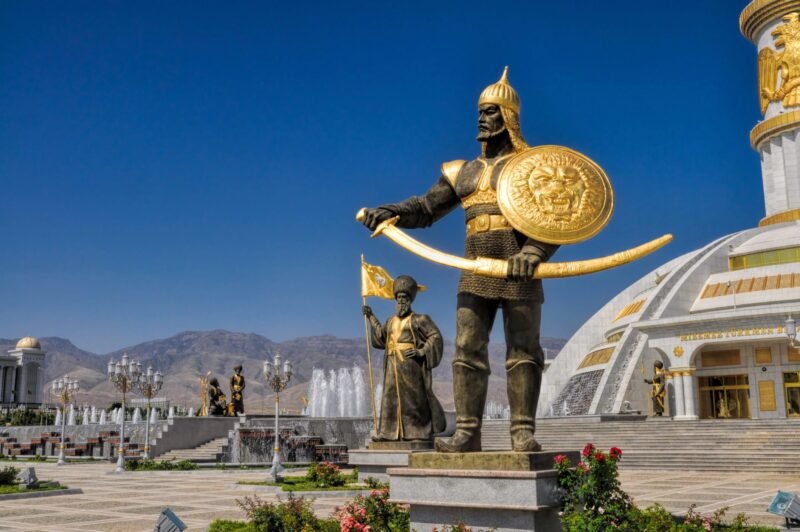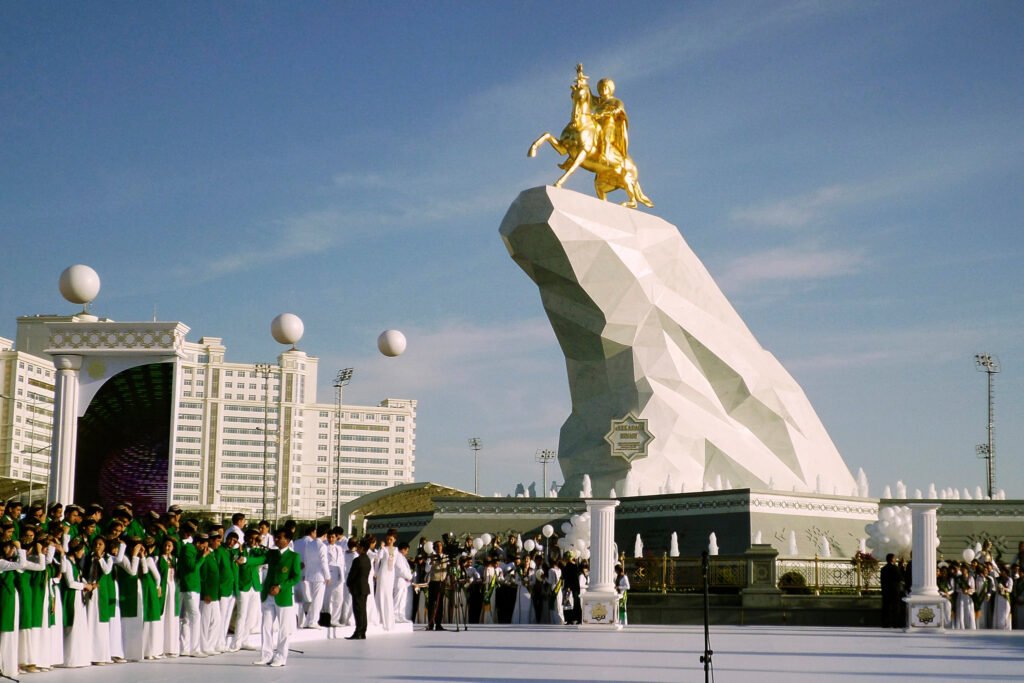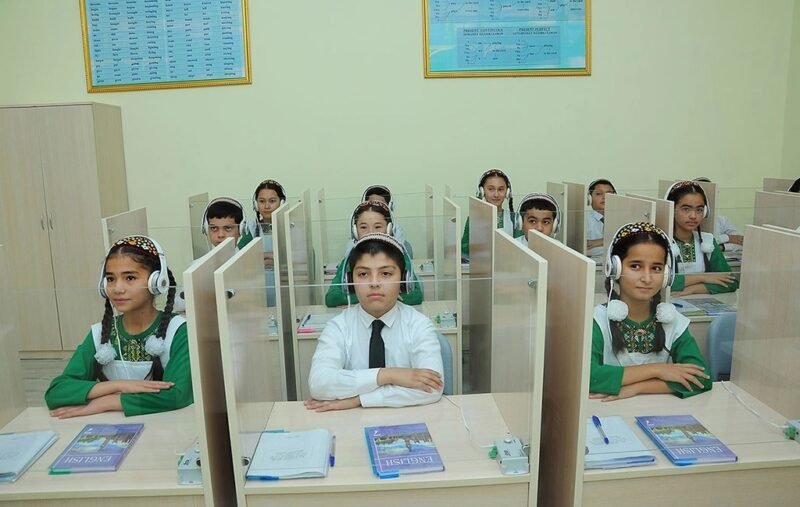Turkmenistan’s overview of Politics, Social infrastructure and Economic relations

Introduction
Almost overnight the countries of Central Asia started getting attention from politicians, academicians and the media due to the collapse of the Soviet State in 1991. The collapse affected the countries profoundly. Among the five republics, Turkmenistan today is the least integrated and is characterized by deep political control, high levels of corruption, and economic dependence on hydrocarbon exports.
Turkmenistan was called the Turkmen Soviet Socialist Republic from 1925 to 1991. It is the southernmost Central Asian Republic. The Karakum desert holds around three-quarters of the land and the largest river in central Asia, the Amu Darya, flows across the desert of eastern Turkmenistan. The Caspian Sea lies on the west side of the country. The country is also known for its vast natural resources. The country holds some of the world’s largest natural gas reserves after the Arab-Iranian and West Siberian basins.
These reserves have allowed the country to attain tangible results in boosting the economy. Turkmenistan, however, encounters challenges in developing its gas reserves, the reason being a lack of adequate infrastructure and investment and at the same time the instability in the global prices for primary energy products.
This article is an attempt to give a brief overview of Turkmenistan with regard to its political, economic, and social sectors.

Turkmenistan before 1991
After the collapse of the Soviet State, many Central Asian industrial establishments lost their markets and were not capable enough to get into competition with the new market conditions. Hence de-industrialization was apparent.
Drawing attention towards Turkmenistan, the country’s electricity sector and construction industry underwent major development during Soviet times. The country became self-reliant and even supplied electricity to the other Central Asian States. On the contrary, the food industry could not satisfy the food requirements of the republic in 1991. The focus on cotton crops made it difficult to gain food independence.
The transportation infrastructure also experienced rapid expansion and so did the country’s textile industry which accounted for nearly a third of the region’s gross industrial output in 1991.
The Soviets significantly increased the areas under cultivation, particularly the main crop, cotton. The water-thirsty cotton fields led to the construction of the Karakum Canal, which became a strong factor in the growth of the region’s potential. But all of this has consequences. The canal is of course only the most dramatic example of the violence perpetrated against man and nature in Soviet Central Asia. The Amu Darya has kept the Aral Sea alive but due to a change in its natural course because of human intervention it became the principal reason for the disappearance of the Aral Sea.
Turkmenistan after 1991
Political Scenario
Central Asia inherited well-developed state institutions and legitimate state borders. The countries are doing well in almost all spheres but it all comes to halt with their independence. All the help from Moscow halted and countries now had to face a host of issues on their own.
There is a democracy deficit in these countries. The fragile character of the political system in these countries is largely due to “facade democracies”. The NGOs are under the strict scrutiny of the state. The civil society movements were repressed in the early years of independence in Turkmenistan when in the other central Asian republics there was a revival of civil society movements. Journalism is also under the control of the state. Reporters Without Borders in the press freedom index 2020 positions the country at the bottom together with North Korea.
President Niyazov got himself elected in 1999 as President for life and named himself Turkembshi (father of Turks). He had created a cult and even students were required to read a book called Rukhnama, which consisted of his collected thoughts on culture, history, and morality. President Niyazov died in December 2006. His successor was Gurbanguly Berdimuhamedov and soon the cult of Niyazov was replaced by Berdimuhamedov.
Social Infrastructure
Under president Niyazov, secondary education was lessened by a year and this caused prolonged harm to the education quality in the country. Studying overseas has become difficult for students. In 2004 around 15,000 healthcare professionals were dismissed and replaced by military conscripts. Further in 2005, Niyazov ordered the closure of all regional hospitals.
President Berdimuhamedov who came into power in 2006 reopened regional hospitals but the country is still behind in providing basic health security. Though the regime has invested heavily in infrastructure and increased the budget for health and education, many projects are still waiting to get implemented.
The central problems faced by the healthcare sector are the lack of medical supply, corruption, the low-grade standard of healthcare in rural regions, and the shortage of medical specialists. There was also a shortage of qualified workers in the country. At the beginning of 2018, there were only 14,200 doctors in the country or 2.5 doctors per 1,000 inhabitants.

Steps taken by the government
A National Educational System has been established and is now operating in Turkmenistan. The steps are taken to improve literacy rates and to create a high-tech educational environment. Several activities are undertaken like improvement in Parent Educational Centers.
The educational policy also keeps in view the gender disparity and works on reducing it through the adoption of The National Action Plan on Gender Equality. Activities are underway to improve the prospects of higher education and vocational learning for students as well. Even the number of students receiving higher education has gone up significantly in recent years.
The government has taken steps in improving the quality of health care also. One such step is the adoption of the National Strategy and Action Plan on Maternal, Newborn, Child and Adolescent Health for 2015-2019. Steps have been carried out to lower the under-five child mortality rate, for example, the Government financed measures on promoting and supporting breastfeeding.
Foreign Policy
In terms of foreign engagement, Turkmenistan adopted the principle of permanent neutrality, confirmed by the United Nations in 1995. There was a focus on preserving the country from external aggression and working on its internal threats. Turkmenistan has kept its distance from the west as well as Russia thus avoiding being a playground for geopolitical rivalries. The country’s reluctance to join any regional organization also plays a negative role in solving issues like drug trafficking, money laundering and pipeline infrastructure construction, water shortages etc. All of them require a transnational approach. It is neither a part of the Collective Security Treaty Organization nor the Shanghai Cooperation Organization. Even Turkmenistan refused to open its airspace to the US during the anti-Taliban campaign, unlike Uzbekistan and Kyrgyzstan.
The observers have asserted that Turkmenistan under Berdimuhamedow has ended the isolationism to become a cooperative regional player. The stable political relations with the Caspian States and the neighbouring country of Afghanistan are considered important elements of a country’s foreign policy. The purpose is to expand its economic contacts with a primary focus on the energy sector.

Economic Scenario
The transition to the market economy is still not completed in Turkmenistan. The country follows protectionist policies and the financial sector is highly repressed. The exports are large of its hydrocarbon resources which constitute a large section of GDP. Though the presence of hydrocarbons has been a great blessing for Turkmenistan to develop rapidly, even in the absence of proper market reforms. It does have its limitations, which are visible in the impact of the 2008 financial crisis and the 2014-15 drop in commodity prices.
There is little foreign direct investment in sectors other than oil and gas production. The relationship with the IMF and World Bank is less developed because of the repressed economic system and unavailability of data.
In order to integrate with other economies and to increase foreign investment, Turkmenistan must complete its basic market reforms. The government needs to further reduce explicit subsidies and there is a need to unify the exchange rate and current account convertibility. The state should undertake policies that could increase the ease of doing business for foreign investors and build gas pipeline infrastructure.
The country is taking active efforts in diversifying its export routes but is facing significant challenges in getting its gas to the market. The competing agendas of other countries in gas supply lines like Iran, Russia, and Caspian states are making it all the more difficult.
With Iran, there are several disputes concerning payment for gas delivered. Iran itself has gas reserves and has begun tapping them. Iran will be a significant competitor to Turkmenistan and its geographic location also provides it with a plus point.
The Turkmenistan–Afghanistan–Pakistan–India Pipeline (TAPI) to India (through Afghanistan and Pakistan) is another important project for Turkmenistan. However, instability in Afghanistan acts as an impediment to the construction of TAPI.
China is also playing a major role here. It has constructed a major gas pipeline from Turkmenistan. The pipeline broke the previous domination of Russia’s Gazprom and made it nearly totally dependent on China. Turkmenistan’s exports to China constituted 1% of its total exports in 2009, increasing to almost 80% by 2015, almost all of which is natural gas.
Recently, the Russian-Ukraine war again led the west to find alternative supplies of gas which has revived the talks of a trans-Caspian pipeline. This line will transport gas from Turkmenistan to Azerbaijan under the Caspian Sea up to Turkey and southern Europe. But the difficult relationship between Turkmenistan and Azerbaijan is making it a challenge. Russia also strongly disapproves of this pipeline.
Conclusion
After independence from the Soviet State, Turkmenistan entered into an era of isolationism, which very recently seems to be ending. The country needs to work with other like-minded countries. Improving the country’s scientific potential and technical prospects should be taken as a priority. The country needs to steer efforts toward gas pipeline infrastructure now be it with Azerbaijan or South Asia.
The UN 2030 agenda is the primary approach of the country to deepen the social orientation of the already established national policies and to acquire balanced growth. After the adoption of SDGs, a change is seen in the form of substantial results in social policies and also in market transformation. The country is showing positive change but there is still a long way to go for Turkmenistan.
References
1. Soucek, Branko, and Svat Soucek. A History of Inner Asia. Cambridge University Press, 2000,
p. 8.
2. Khalova, G. O., et al. “Economic Reforms and Macroeconomic Policy in Turkmenistan.” Russian & East European Finance and Trade, vol. 35, no.5, 1999, pp. 11, http://www.jstor.org/stable/27749497. Accessed 16 May 2022.
3. Roy, J. N., and Braja Bihārī Kumāra. India and Central Asia. Concept Publishing Company, 2007, p. 125.
4. “Turkmenistan: Freedom in the World 2021 Country Report | Freedom House.” Freedom House, https://freedomhouse.org/country/turkmenistan/freedom-world/2021. Accessed 17 May 2022
5. “BTI 2022 Turkmenistan Country Report.” BTI 2022, https://bti- project.org/en/reports/country-report/TKM. Accessed 17 May 2022.
6. Government of Turkmenistan. Ashgabat Turkmen State Publishing Service, 2019, pp. 15-29, Voluntary National Review of Turkmenistan.
7. Batsaikhan, Uuriintuya, and Marek Dabrowski. “Central Asia — Twenty-Five Years after the Breakup of the USSR.” Russian Journal of Economics, no. 3, NP Voprosy Ekonomiki, Sept. 2017, p. 308. https://doi.org/10.1016/j.ruje.2017.09.005


















